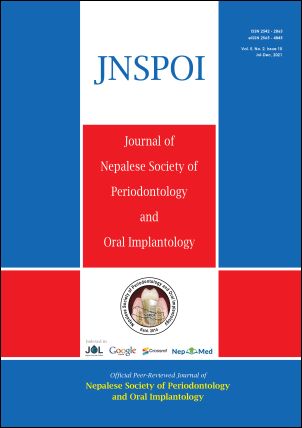Maxillary Sinus Septa: Prevalence and Variation with Gender and Location
DOI:
https://doi.org/10.3126/jnspoi.v5i2.52977Keywords:
Maxillary sinus, prevalence, septa, variationAbstract
Introduction: Maxillary sinus septa are partitions of cortical bone dividing the sinus into multiple compartments. Their presence and dimension are of relevance to periodontists, oral and maxillofacial surgeons as well as otolaryngologists.
Objective: To determine the prevalence of maxillary sinus septa and its variation with gender and location in sampled Nepali population.
Methods: An analytical cross-sectional study was conducted in Department of Periodontics, Kantipur Dental College Teaching Hospital and Research Centre after ethical clearance from Institutional Review Committee. Convenience sampling was done for 433 orthopantomograms (OPGs) with clearly visible maxillary sinus and absence of pathological or developmental changes. Each OPG was observed for presence of septa. Presence or absence of septa was noted along with position and site of septa. Gender of subjects was also noted. Statistical analysis was performed via SPSS 21.0.
Results: Among observed radiographs, 148 (34.18%) showed presence of maxillary sinus septa. Septa were more prevalent among males (84, 56.76%) than females 64 (43.24%); with statistically significant difference (P <0.05). Unilateral occurrence (97, 65.54%) of septa was greater than bilateral (51, 34.46%).
onclusion: This study may serve as baseline data for prevalence of maxillary sinus septa and may aid in treatment planning during dental implant placements and surgical procedures of maxillary sinus.
Downloads
Downloads
Published
How to Cite
Issue
Section
License
Copyright (c) 2021 Nepalese Society of Periodontology and Oral implantology (NSPOI)

This work is licensed under a Creative Commons Attribution 4.0 International License.
© Nepalese Society of Periodontology and Oral implantology (NSPOI)
Licenced by Creative Commons Attribution 4.0 International License.




